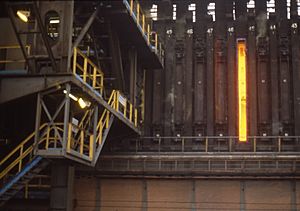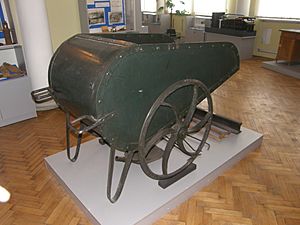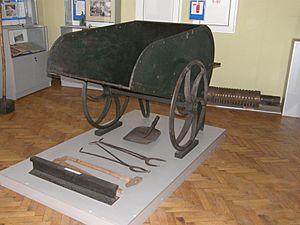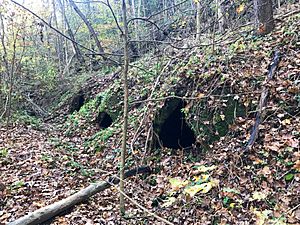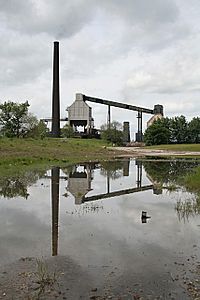Coke (fuel) facts for kids
Coke is a type of fuel that has very few impurities and a lot of carbon. It is usually made from coal. Think of it as a solid, black, and porous material. It's created by heating coal in a special way. While coke can sometimes form naturally, the kind we use most often is made by people. There's also a type called petroleum coke, which comes from oil refineries.
Coke is used as a fuel. It also helps to remove oxygen from iron ore when making iron in a large oven called a blast furnace. The carbon monoxide gas made when coke burns helps turn iron oxide (which is like rust) into pure iron.
Even though coke costs more than regular coal, it can be used in homes. It burns much cleaner, making less smoke and fewer impurities. Today, people use oil or gas more for heating. But in the 1900s, coke was often used in kitchen stoves.
The Story of Coke
People in ancient China were making coke as early as the 4th century. The Chinese first used coke for heating and cooking around the 800s. By the early 1000s, Chinese iron workers in the Yellow River valley started using coke to power their furnaces. This was a great solution because there weren't many trees in that area for wood.
In 1709, a man named Abraham Darby I started using coke in a blast furnace to make cast iron. Coke is very strong, which meant blast furnaces could be built taller and bigger. This made iron much cheaper and was a big reason for the start of the Industrial Revolution. Before coke, iron was made using lots of charcoal, which comes from burning wood.
As forests couldn't provide enough wood, people in Great Britain started using coke instead of charcoal. They made coke by burning coal in large piles on the ground. Only the outside of the pile would burn, leaving the inside as carbonized coke. Later, in the late 1700s, special brick ovens called beehive ovens were invented. These ovens gave people more control over how the coke was made.
In the United States, coke was first used in an iron furnace around 1817. This happened in Fayette County, Pennsylvania. In the late 1800s, the coalfields of western Pennsylvania had lots of coal for making coke. In 1885, a company built the world's longest line of coke ovens in Walston, Pennsylvania. It had 475 ovens stretching over 2 kilometers (1.25 miles). These ovens could produce 22,000 tons of coke each month! The Minersville Coke Ovens in Huntingdon County, Pennsylvania, are now a historic site.
Even though coke was a great fuel, making it caused a lot of pollution. After 1900, the serious environmental problems from beehive coking became well-known. One observer in 1911 noted that "the smoke and gas from some ovens destroy all plants around the small mining towns." Another person traveling by train saw "long rows of beehive ovens from which flame is bursting and thick clouds of smoke coming out, making the sky dark."
How Coke is Made
To make coke, coal is baked in a special oven or furnace. This oven has no air inside. The temperature can go as high as 2,000 °C (3,600 °F), but it's usually around 1,000–1,100 °C (1,800–2,000 °F). This process drives off the gases and liquids from the coal, like water and coal-tar. What's left behind is the solid carbon and ash, which fuse together to form coke.
The coal used for making coke, called coking coal, needs to meet certain standards. Scientists check things like how much moisture, ash, and sulfur it has. They also check its "volatile content" (how much gas comes off when heated) and how "plastic" it is (how it melts and sticks together). Different types of coal are often mixed together. This helps make sure the final coke is strong enough. It's generally best if the coal mix has about 26–29% volatile matter for good coking.
What is Coke Used For?
Coke is used as a fuel. It's also a reducing agent in smelting iron ore in a blast furnace. When coke burns, it creates carbon monoxide. This gas helps to remove oxygen from iron oxide (like hematite) to make pure iron.
Blacksmiths often use coke as fuel for their work.
In Australia, during the 1960s and early 1970s, coke was used to heat houses.
Because the smoke-producing parts are removed when coal is turned into coke, coke is a good fuel for stoves and furnaces. It burns with little or no smoke, unlike regular coal which produces a lot. In the United Kingdom, coke became widely used for home heating after "smokeless zones" were created.
The Highland Park distillery in Orkney uses a mix of coke and peat to roast the malted barley for their Scotch whisky.
Coke was also discovered by accident to be great for heat shielding when mixed with other materials. It was used in the heat shielding for NASA's Apollo Command Module. This special material was called AVCOAT 5026-39. More recently, it was used as the heat shielding on the Mars Pathfinder vehicle. NASA had also planned to use coke for the heat shield of its next generation spacecraft, Orion.
Images for kids
-
The original blast furnaces at Blists Hill, Madeley
-
Hanna furnaces of the Great Lakes Steel Corporation, Detroit. Coal tower atop coke ovens. November 1942
-
The Illawarra Coke Company (ICC) in Coalcliff, New South Wales, Australia
-
Coal coking ovens at Cokedale, Colorado, supplied steel mills in Pueblo, CO
-
The 200 Cherry Valley Coke Ovens built around 1866
See also
 In Spanish: Coque para niños
In Spanish: Coque para niños


